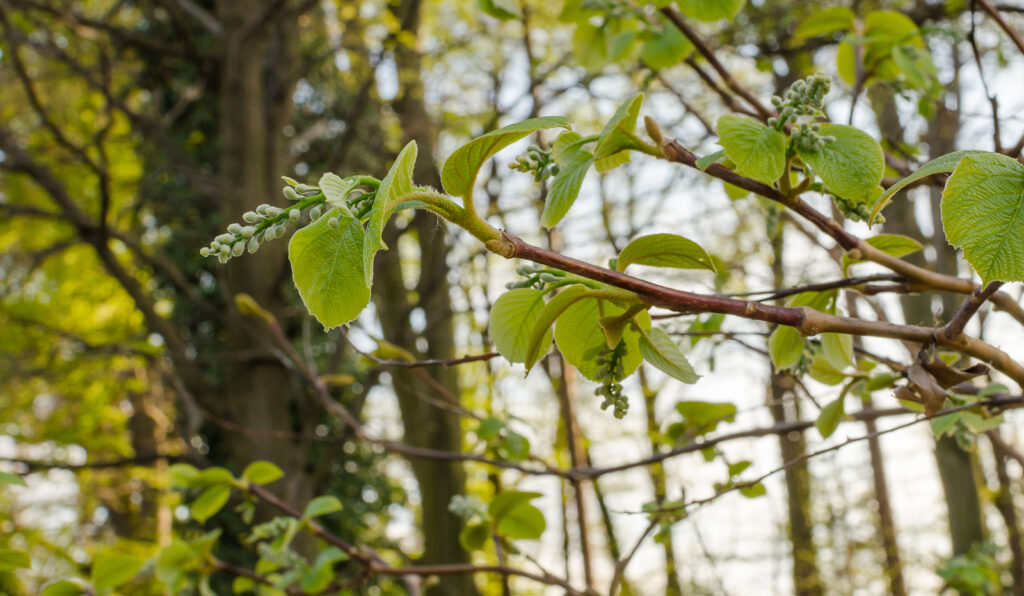Styrax–commonly called snowbell–are small trees and shrubs with dainty, nodding, bell-shaped fragrant white flowers. The flowers are produced in racemes and panicles in clusters on short branches.
Styrax have slender, graceful trunks and strongly horizontal branches; they are flat topped. Leaves angle upward from branches while flowers hang down; the effect is of parallel green and white tiers.
Styrax trees are modest and are well suited for patios and small gardens. Styrax can be grown as specimens or in a woodland garden. Styrax roots grow deep and are nonaggressive.
Styrax is a genus of about 100 species. Styrax is native to woodland and thickets in Europe, Asia, and North America.

Get to know Styrax
- Plant type: Deciduous trees
- Growing zones and range: Zones 5 to 9
- Hardiness: Hardy to Zone 5
- Height and width: To 30 feet (9.1m) tall and nearly as wide
- Form and habit: Wide-spreading crown
- Foliage: Alternate, short-stalked, variably shaped, entire or toothed glossy summer leaves are rich green; in fall they turn yellowish or red; smooth gray-brown bark
- Flowers: White, bell-shaped fragrant flowers hanging in clusters; as flowers mature, petals arch backward, revealing the colorful centers
- Fruits: .5 inch (1.3cm) gray or greenish white egg-shaped fruits
- Bloom time: Early summer
- Uses: Patios, lawns, light shade, woodland garden, specimen plant
- Garden companions: In front of larger, darker-leafed trees
- Common name: Snowbell
- Botanical name: Styrax
- Family name: Styracaceae
- Origin: Europe, Asia, and North America, including Mexico
Where to plant Styrax
- Plant Styrax in full sun or partial shade.
- Plant Styrax in good, well-drained, nonalkaline soil; tolerate clay; amend soil heavily with peat moss to ensure moisture retention, and mulch well to keep the roots cool.
- Styrax grow poorly in dry to alkaline soil.
When to plant Styrax
- Sow seed as soon as ripe; keep at 59°F (15°C) for 3 months, then at 32-41°F (0-5°C) for 3 months.
- Set out a young container grown Styrax in early spring and provide winter protection from sweeping winds for the first few years.
- Transplant small container-grown or balled-and-burlapped Styrax in early spring.
Planting and spacing Styrax
- Styrax are easy to garden under, since roots are deep and nonaggressive.
- Plant Styrax 25 feet (8m) apart.
How to water and feed Styrax
- Give Styrax regular water.
- Feed Styrax with an all-purpose organic fertilizer in spring
How to care for Styrax
- Prune Styrax in summer only if necessary to shape the plant.
Styrax pests and diseases
- Styrax have no serious pests or diseases.
Styrax propagation
- Take Styrax cuttings in summer.
- Sow Styrax seed in summer; may take 2 years to germinate.
Styrax varieties to grow
- Styrax japonicus, Japanese snowdrop tree, Japanese snowbell, to 30 feet (9.1m) tall and 25 feet (8m) wide, with slender, graceful trunk; branches often strongly horizontal, giving tree a broad, flat top. Oval, scallop-edged leaves to 3 inches (7.6cm) long; turn from dark green to red or yellow in fall. Faintly fragrant, .8 inch (2cm) white flowers hang in small clusters on short side branches. Leaves angle upward from branches while flowers hang down, giving the effect of parallel green and white tiers. Prune to control shape; tends to be shrubby unless lower side branches are suppressed. Splendid tree to look up into; plant it in raised beds near outdoor entertaining areas, or in a high bank above a path.
- S. obassia, Fragrant snowbell, to 20-30 feet (6.1-9.1m) tall and 22 feet (7m) wide, rather narrow. Oval to round, deep green, 3-8 inches (7.6-20.3cm) long leaves. White frosts come very late, leaves may color yellow in autumn. Fragrant flowers to 1 inch (2.5cm) long are carried in drooping, 6-8 inch (15.2-20.3cm) clusters at branch ends and may be partly obscured by foliage. Blooms a little earlier than S. japonicus. Good against background of evergreens, or for the height and contrast above border of rhododendrons and azaleas.



